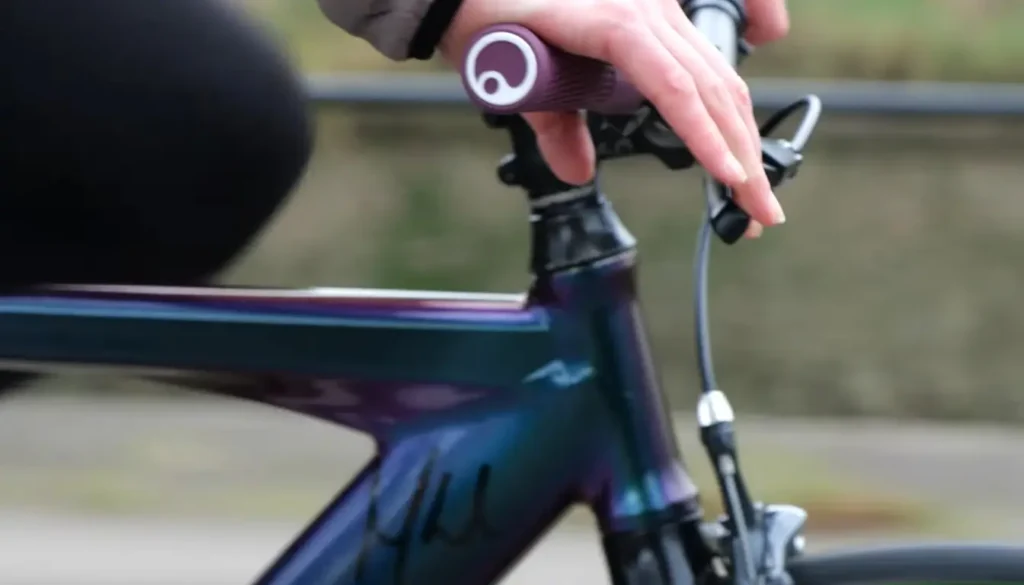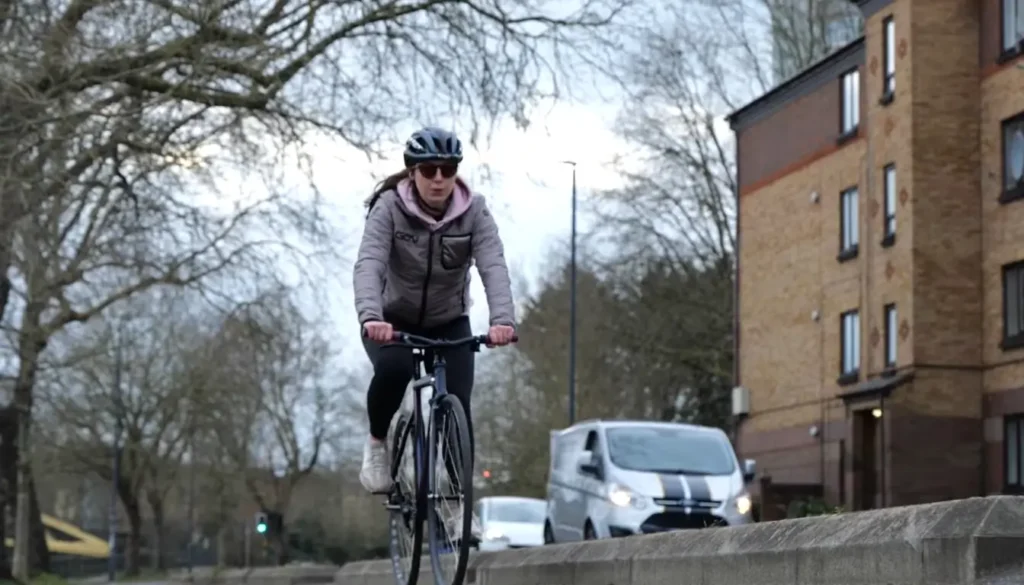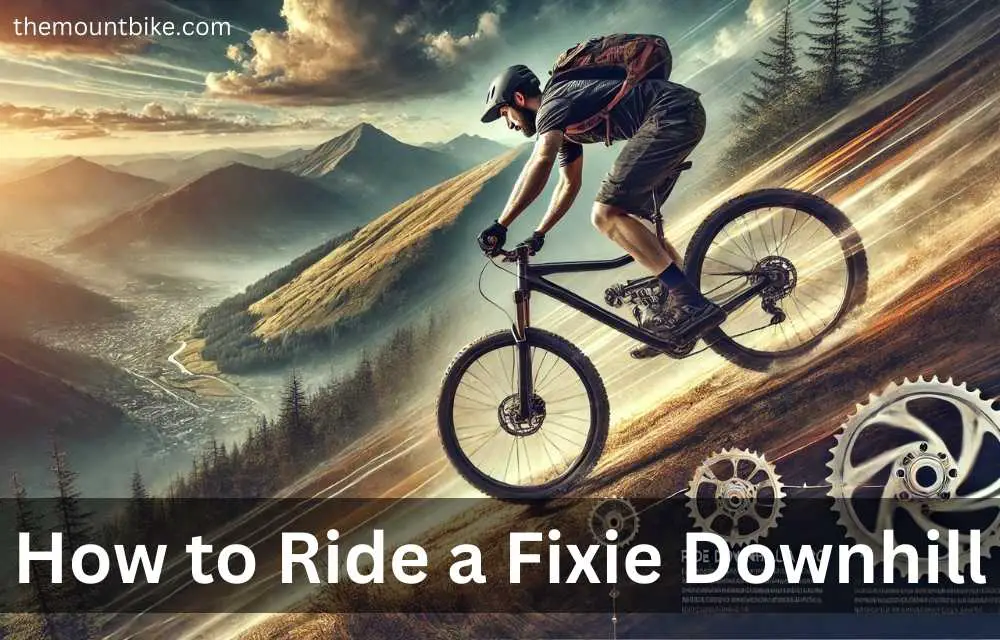Having a basic knowledge of the bike’s brake system, how it works, and gear ratio is the fundamental aspect. And your cycling experience level, maintaining a good rhythm and momentum when riding is the side aspect. Once you combine all of them, you can ride your fixie downhill like a pro.
Due to a lack of information, and confidence, many bikers face challenges when riding a fixed bike downhill. And they need to know how to ride a fixie downhill to be a safer cyclist.
Are you one of them?
If so, don’t worry. In this post, we’ll discuss the process in detail. But before that, let’s know what the fixie bike is, and how it works.
What is a Fixie Bike?
Fixie is the alternative name for fixed-gear bikes. Basically, these bikes come with a single/fixed gear and without any freewheel mechanism. So the pedals will continue turning when the bike is in motion/cadence.
What Are The Brake Systems Of Fixed-gear Bikes?
Fixed-gear bikes come with various braking systems. Such as
Rim brake
There is a brake pad in this braking system and by pressing it against the rim of the side, the bike will be slowed down or stopped.
Disc and coaster brakes
You’ll find disc and coaster brakes in the rear hub. When you turn the pedals in the opposite direction, these brakes will activate to slow down or stop the bike.
Why Should You Know The Braking System of The Fixie Bikes to Ride It Downhill?
You may think, “I’m here to learn about riding a fixie bike downhill. I don’t need to learn how it works. Why is this information here? Without telling me the core info. These are beating about the bush”
That’s not, my dear friend. You should know them to have a clear idea of how to slow down the bike for safer rides.
Because, when researching, I have read lots of Reddit posts. And found
- Most riders use the front brakes to slow down their speed to ride downhill because it’ll do 70% of the braking.
- Pressing the front brake will lock the front wheel. In that case, the novice riders worry that they may go straight away over the bars. As the back wheel is still moving.
- But theoretically and practically, the front brake alone offers the maximum speed slowing power.
- So with proper practice, and knowing the details about the bike’s working mechanism you can get 100% control over your bike, even when downhill.
How To Ride A Fixie Downhill?

There are three rules for riding a fixie downhill with the highest efficiency and no risk of injury.
The First Rule Is To Practice
You will feel too much tension on your legs and face difficulties maintaining speed control while going downhill, for lack of experience.
So, you have to first practice riding the bike on flat and city roads. It’ll boost your confidence, and help to avoid leg muscle tension and overcome difficulties.
Practice Technique
- Forcefully pedal the bike for 10 seconds to get the momentum and better traction of the wheels.
- After that, stop pedaling for the next 5 seconds, and use the speed going forward.
- In the meantime, the extra speed that you produce during paddles will slow down.
- Again padel for 10 seconds and stop for 5 seconds.
- Repeat the process.
Practice Time Frame
So, you got the technique. Now, what about the practice time, right?
- You can practice every day for 30 minutes as a season.
- During practice, maintain a speed between 65 to 75 kilometers per hour. Because it’s the best rhythm for downhill riding.
- An average of one month of practice on flat roads will help you to generate a basic skill to properly handle the bike on the hill track.
- But, that’s not fixed. The more you practice, the more pro downhill rider you will be.
The Second Rule Is Properly Use The Brakes
Slightly pulling the front brake will reduce the front wheel’s motion, but still, there is motion in the rear wheel. This time, the rear wheel skids the traction, and when you don’t do any more paddling. It’ll limit the speed.
The Third Rule Is To Set The Right Gear
Since riding downhill involves gravity, it’ll require higher gear than on flat roads to maintain perfect momentum. Choosing the higher gear also helps you to apply an adequate amount of pedal pressure on the front wheel instead of the rear wheel. So that, you can accelerate speed based on your movement.
However, you should keep in mind your legs’ strength to avoid tension, and surface slopes to cope with them.
Expert Riders Tips Safely Ride A Fixie Downhill

Being an expert in any particular field needs lots of hard work, and going through countless tests and errors. In their learning journey, they’ll discover gems of the field. And getting suggestions or tips from them will reduce your toil to be an expert, and save time. So, now we’ll share some top-notch tips from pro cyclists.
- Start slowly on a relatively flat surface to practice. Learn the skill of controlling your bike without coasting or brake help.
- When you are comfortable with the technique. Start gently inclines progression to gradually increase terrain difficulties.
- Develop strong pedal strokes that’ll help you control and manage your speed level while going downhill. That time, you can use a lower gear ratio to make it easier to maintain adequate control while descending.
- Besides developing physical skills, you should also consider developing mental skills.
- Holding focus and concentration during the ride helps you avoid accidental falling.
- Even in an emergency, staying calm and not panicking is important to gain control and avoid accidents.
- Wear appropriate safety gear (helmets, gloves, and knee pads) as protection in case of falling.
FAQs
Is the Number of chainring teeth important for riding fixie downhill?
Not exactly, but yes it’s important. The more teeth your chainring has, the higher path you can go with one padel. However, you can choose a 32-40T chainring for downhill riding.
How to brake on a fixie?
The thumb rule for braking on a fixie is to slow down your pedaling rhythm and press the front brake to apply pressure. Remember, you shouldn’t squeeze the brake hard because it’ll increase the front wheel locking risk. As a result, you may fly over the handlebars.
Is Fixie good for downhill?
There is no black-and-white answer. If you have enough skills and experience riding fixie bikes, it’s good for downhill. On the other hand, if you are a beginner and have no experience in downhill riding. Fixie bikes aren’t good for downhill.
Safely Ride A Fixie For Downhill
Practice. Experience. Right gear. Proper brakes. Focus. Those are the words you have to be aware of when riding your fixie bike downhill.
Once you combine all of them, you can enjoy your rides like a free bird without any tension of falling, flying over the handlebars, and hitting other vehicles on the roads.
Control the speed, and be a winner of downhill rides.

I am Ryan Ford, a mountain biking enthusiast who loves to explore the outdoors. I also like to go on adventures with friends and anything else that involves being outside. I love my bike because it gets me out of the house and gives me an opportunity to enjoy nature.

